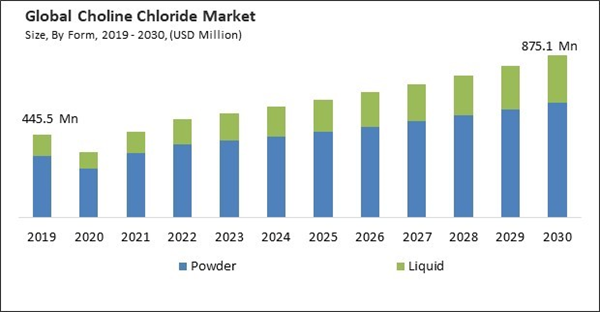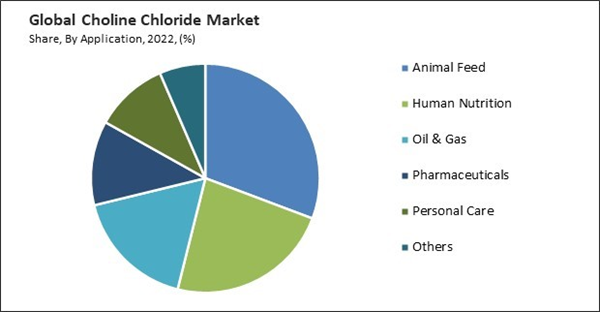The Global Choline Chloride Market size is expected to reach $875.1 Million by 2030, rising at a market growth of 6.5% CAGR during the forecast period. In the year 2022, the market attained a volume of 4,07,131.8 Tonnes, experiencing a growth of 6.2% (2019-2022).
Choline chloride in the oil and gas segment effectively stabilizes clay. It helps control the swelling of clays in drilling mud, preventing them from clogging the drilling equipment and wellbore. This ensures smoother drilling operations and reduces the risk of costly downtime associated with drilling fluid-related issues. Therefore, the Oil & Gas segment would acquire 1/5th share of the market by 2030. Choline chloride plays a crucial role in controlling the viscosity of drilling fluids. It helps maintain the desired fluid properties, ensuring that the drilling mud remains optimal for efficient drilling. It is considered an environmentally friendly clay stabilizer compared to some alternative chemicals. Its use can lower the environmental impact of drilling operations, which aligns with the industry's increasing focus on sustainability and responsible drilling practices. Some of the factors impacting the market are increasing demand for animal feed, rising awareness of animal nutrition, and fluctuation in raw materials’ prices.
The primary driver of the market is its extensive use in animal feed, especially in poultry, swine, and aquaculture industries. As global meat and seafood consumption continues to rise, there is a growing need to enhance animal health and productivity. It is an essential nutrient for livestock. It is crucial in various metabolic processes, including fat metabolism and liver function. With rising awareness of the importance of animal nutrition, there is a growing emphasis on providing balanced diets to animals. It is added to animal feed to enhance the nutritional content and promote optimal growth and overall health. Additionally, Animal nutrition has evolved to prioritize nutrient optimization. It is a vital nutrient supporting animal growth, reproduction, and overall health. This recognition has driven the demand for choline chloride in animal feed to ensure that animals receive the essential nutrients. Awareness of the role of choline chloride in improving feed efficiency has prompted its widespread adoption in animal nutrition. Farmers and producers aim to maximize feed conversion into meat, milk, or eggs; it is crucial in achieving this efficiency. The awareness that animal nutrition directly affects the quality of meat and dairy products has increased the demand for high-quality feeds. It enhances meat quality, flavor, and texture and improves milk production and composition in dairy animals. The rising awareness of animal nutrition positively impacts the market.
However, choline chloride prices can be volatile, influenced by raw material costs, production efficiency, and market demand. This can pose challenges for both producers and buyers. It is produced from raw materials such as ethylene oxide and trimethylamine. Variations in manufacturing capacity, energy prices, and the dynamics of supply and demand can all affect the price of these raw materials. Any significant changes in raw material costs can impact the price of choline chloride. The efficiency of choline chloride production processes is crucial in determining its final price. Improved production methods and technology can lead to cost savings, while production disruptions or inefficiencies can increase costs and, in turn, affect pricing. Price volatility is a significant challenge in the market.
The market research report covers the analysis of key stake holders of the market. Key companies profiled in the report include Merck KGAA, Kemin Industries, Inc., Balchem Corporation, Eastman Chemical Company, Spectrum Chemical Mfg. Corp (Spectrum Laboratory Products, Inc.), BASF SE, Tokyo Chemical Industry Co. Ltd., Nuproxa Switzerland Ltd, Pestell Nutrition Inc. (Barentz), and Algry Quimica S.L.
Choline chloride in the oil and gas segment effectively stabilizes clay. It helps control the swelling of clays in drilling mud, preventing them from clogging the drilling equipment and wellbore. This ensures smoother drilling operations and reduces the risk of costly downtime associated with drilling fluid-related issues. Therefore, the Oil & Gas segment would acquire 1/5th share of the market by 2030. Choline chloride plays a crucial role in controlling the viscosity of drilling fluids. It helps maintain the desired fluid properties, ensuring that the drilling mud remains optimal for efficient drilling. It is considered an environmentally friendly clay stabilizer compared to some alternative chemicals. Its use can lower the environmental impact of drilling operations, which aligns with the industry's increasing focus on sustainability and responsible drilling practices. Some of the factors impacting the market are increasing demand for animal feed, rising awareness of animal nutrition, and fluctuation in raw materials’ prices.
The primary driver of the market is its extensive use in animal feed, especially in poultry, swine, and aquaculture industries. As global meat and seafood consumption continues to rise, there is a growing need to enhance animal health and productivity. It is an essential nutrient for livestock. It is crucial in various metabolic processes, including fat metabolism and liver function. With rising awareness of the importance of animal nutrition, there is a growing emphasis on providing balanced diets to animals. It is added to animal feed to enhance the nutritional content and promote optimal growth and overall health. Additionally, Animal nutrition has evolved to prioritize nutrient optimization. It is a vital nutrient supporting animal growth, reproduction, and overall health. This recognition has driven the demand for choline chloride in animal feed to ensure that animals receive the essential nutrients. Awareness of the role of choline chloride in improving feed efficiency has prompted its widespread adoption in animal nutrition. Farmers and producers aim to maximize feed conversion into meat, milk, or eggs; it is crucial in achieving this efficiency. The awareness that animal nutrition directly affects the quality of meat and dairy products has increased the demand for high-quality feeds. It enhances meat quality, flavor, and texture and improves milk production and composition in dairy animals. The rising awareness of animal nutrition positively impacts the market.
However, choline chloride prices can be volatile, influenced by raw material costs, production efficiency, and market demand. This can pose challenges for both producers and buyers. It is produced from raw materials such as ethylene oxide and trimethylamine. Variations in manufacturing capacity, energy prices, and the dynamics of supply and demand can all affect the price of these raw materials. Any significant changes in raw material costs can impact the price of choline chloride. The efficiency of choline chloride production processes is crucial in determining its final price. Improved production methods and technology can lead to cost savings, while production disruptions or inefficiencies can increase costs and, in turn, affect pricing. Price volatility is a significant challenge in the market.
Application Outlook
Based on application, the market is classified into animal feed, oil & gas, human nutrition, personal care, pharmaceuticals, and others. In 2022, the animal feed segment witnessed the largest revenue share in the market. Choline chloride is extensively used as a vitamin substitute or supplement in animal feed additives for poultry, swine feed, and fish farming. An increase in disposable income and a rise in poultry meat consumers drive the demand for the market. Poultry animals are vulnerable to contagious diseases and tend to lack choline content. Choline content in animal feed additives is essential as it promotes faster growth and helps to overcome perosis (slipped tendon) in poultry animals. Moreover, deficiency of choline content in swine leads to spraddle or splayed legs, deprived reproduction & lactation, and fatty liver infiltration, thus affecting growth. The use of choline chloride-containing animal feed additives benefits poultry, swine feed, and fish farming.Form Outlook
By form, the market is categorized into powder and liquid. The liquid segment covered a considerable revenue share in the market in 2022. Liquid choline chloride is widely used in the animal nutrition sector, especially in livestock feed production. It is essential for animals, particularly poultry, swine, and aquaculture. The liquid form is convenient for mixing into feed formulations, ensuring even distribution and accurate dosing. Liquid choline chloride is utilized in pharmaceutical manufacturing as a precursor for various drug compounds. Liquid choline chloride is sometimes a flavor enhancer in the food and beverage industry. Its liquid form can be added to food products, enhancing flavor profiles in specific applications.Regional Outlook
Region-wise, the market is analysed across North America, Europe, Asia Pacific, and LAMEA. In 2022, the Asia Pacific region led the market by generating the highest revenue share. Choline chloride use in animal nutrition has increased significantly in the APAC region due to its significant livestock and aquaculture sectors. Countries like China and India have experienced significant poultry and swine production growth. The APAC region is a global leader in aquaculture production. The APAC region is a global leader in aquaculture production. Choline chloride is used in fish and shrimp feeds to enhance growth and health. The expansion of the aquaculture industry has led to a growing market in the region.The market research report covers the analysis of key stake holders of the market. Key companies profiled in the report include Merck KGAA, Kemin Industries, Inc., Balchem Corporation, Eastman Chemical Company, Spectrum Chemical Mfg. Corp (Spectrum Laboratory Products, Inc.), BASF SE, Tokyo Chemical Industry Co. Ltd., Nuproxa Switzerland Ltd, Pestell Nutrition Inc. (Barentz), and Algry Quimica S.L.
Scope of the Study
Market Segments Covered in the Report:
By Form (Volume, Tonnes, USD Thousands, 2019-2030)- Powder
- Liquid
- Animal Feed
- Human Nutrition
- Oil & Gas
- Pharmaceuticals
- Personal Care
- Others
- North America
- US
- Canada
- Mexico
- Rest of North America- Europe
- Germany
- UK
- France
- Russia
- Spain
- Italy
- Rest of Europe- Asia Pacific
- China
- Japan
- India
- South Korea
- Singapore
- Malaysia
- Rest of Asia Pacific- LAMEA
- Brazil
- Argentina
- UAE
- Saudi Arabia
- South Africa
- Nigeria
- Rest of LAMEA
Key Market Players
List of Companies Profiled in the Report:
- Merck KGAA
- Kemin Industries, Inc.
- Balchem Corporation
- Eastman Chemical Company
- Spectrum Chemical Mfg. Corp (Spectrum Laboratory Products, Inc.)
- BASF SE
- Tokyo Chemical Industry Co. Ltd.
- Nuproxa Switzerland Ltd
- Pestell Nutrition Inc. (Barentz)
- Algry Quimica S.L.
Unique Offerings
- Exhaustive coverage
- The highest number of Market tables and figures
- Subscription-based model available
- Guaranteed best price
- Assured post sales research support with 10% customization free
Table of Contents
Chapter 1. Market Scope & Methodology
Chapter 2. Market At a Glance
Chapter 3. Market Overview
Chapter 4. Global Choline Chloride Market, By Form
Chapter 5. Global Choline Chloride Market, By Application
Chapter 6. Global Choline Chloride Market, By Region
Chapter 7. Company Profiles
Companies Mentioned
- Merck KGAA
- Kemin Industries, Inc.
- Balchem Corporation
- Eastman Chemical Company
- Spectrum Chemical Mfg. Corp (Spectrum Laboratory Products, Inc.)
- BASF SE
- Tokyo Chemical Industry Co. Ltd.
- Nuproxa Switzerland Ltd
- Pestell Nutrition Inc. (Barentz)
- Algry Quimica S.L.
Methodology

LOADING...










